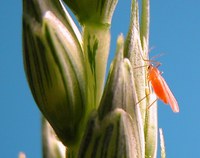Wheat Midge Forecast Improved for 2012
(Click the image below to view a high-resolution image that can be downloaded)
Soil samples in North Dakota indicate lower levels of overwintering wheat midge larvae (cocoons) for the 2012 season.
“With only 12 percent of the samples statewide being moderate to high risk for wheat midge infestation, most wheat producers should get a break from insecticide costs,"" according to Janet Knodel, North Dakota State University Extension Service entomologist.
A total of 142 soil samples were collected from 20 counties to estimate the regional risk. The distribution of wheat midge in the 2012 forecast map is based on unparasitized cocoons found in the soil samples collected in the fall of 2011.
""Although the wheat midge populations fell from last year’s high, there still are a few pockets of moderate to high risk that need to be monitored closely in the northwestern and north-central regions of North Dakota,"" Knodel says.
In 2011, wheat midge populations ranged from zero to 1,879 midge larvae per square meter, with an average of 171 larvae per square meter. In contrast, wheat midge populations ranged from zero to 3,750 midge larvae per square meter, with an average of 417 larvae per square meter in 2010.
“The decrease in the wheat midge population can be attributed to the wet spring, which delayed the planting of wheat until June 5 to 12 in the northern tier,” Knodel says. “This was later than the typically early to mid-May planting date and, based on the planting model for susceptibility to wheat midge, was just within the 600 growing degree days, which is the end of the susceptible period of wheat to wheat midge. Late planting dates, after 600 growing degree days, can mitigate midge damage. In addition, a large amount of agricultural acreage went into prevent planting, especially in the northwestern region of North Dakota. This reduced the availability of host crops to wheat midge.”
Areas where populations of cocoons exceed 1,200 per square meter are at a high risk for wheat midge infestation in 2012, but accounted for only 2 percent of the samples. These areas include isolated pockets in central Burke and southwestern McHenry counties.
“If wheat is planted in these high-risk areas, producers must be prepared to monitor the fields closely for wheat midge infestations and include the cost of an insecticide in their wheat production budget,” Knodel says. “Otherwise, undetected and uncontrolled infestations may result in significant yield losses. Fortunately, the price of wheat is high, which should make pest management decisions easier for producers.”
Wheat midge populations of 501 to 1,200 midge larvae per square meter (moderate risk) account for only 9 percent of the samples. Areas at moderate risk include central Divide, central and southeastern Bottineau, eastern Ward, west-central McLean, southwestern McHenry, northern and southern Pierce, western Rolette and southern Cavalier counties. Areas where populations are above 500 larvae per square meter also will require close monitoring by wheat producers.
In most of the remaining counties, 42 percent of the samples had 201 to 500 larvae per square meter (low risk) and 33 percent had zero larvae per square meter. Although these areas with 201 to 500 midge larvae per square meter are considered low risk, it is good insurance to scout fields to determine if an action threshold population level exists.
Wheat midge larvae feed on the kernel and negatively affect yield, grade and quality. If the wheat crop is heading during adult wheat midge emergence, adult midges can cause severe injury to the kernels, which would affect yields.
Early planting and selecting an early maturing variety of hard red spring wheat is one of the best preventive strategies to mitigate wheat midge populations.
“Early planting (prior to 200 growing degree days using a base of 40 F) can reduce midge damage because the wheat will flower before peak midge emergence,” Knodel says. “Wheat is most susceptible from heading to 80 percent of the primary heads with anthers. Planting between 200 and 600 degree days is the high-risk window for planting wheat because wheat midge will be emerging during heading. Producers who must plant during this window should stagger their planting dates. Late-planted wheat (after 600 degree days) will miss the peak emergence of wheat midge but runs the risk of lower yields, frost damage or even greater losses due to barley yellow dwarf virus, which is a virus transmitted by cereal aphids.”
The parasitic wasp, Macroglenes penetrans, plays an important role in keeping wheat midge in check naturally most years by killing the wheat midge larvae. The average parasitism rate for the wasp was 19 percent in 2011, compared with 17 percent in 2010 and 13 percent in 2009.
Parasitism ranged from 0 percent to 100 percent across the state, with the higher rates occurring in areas where midge populations have been high the past few years. More than half of the samples in 2011 (52 percent) had zero parasitism, which could cause wheat midge populations to increase in future years.
“We need to continue to conserve parasitic wasp populations when possible by spraying insecticides only when necessary,” Knodel says. “Also, avoid any late insecticide applications to minimize any negative impacts on the parasitic wasps, which are active at that time.""
The soil samples were collected by NDSU Extension Service agents in the fall of 2011. Midge larvae are extracted from the soil samples in Department of Entomology laboratories at NDSU.
The wheat midge soil survey is supported by the North Dakota Wheat Commission.
NDSU Agriculture Communication – Feb. 8, 2012
| Source: | Janet Knodel, (701) 231-7915, janet.knodel@ndsu.edu |
|---|---|
| Editor: | Rich Mattern, (701) 231-6136, richard.mattern@ndsu.edu |


